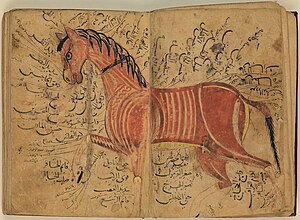
Back الفروسية في التاريخ الإسلامي Arabic Furûsiyya Catalan Furusiyya Spanish Furûsiyya French פורוסייה HE Furusiyya Italian Farys Polish فروسيہ PNB فروسيہ Urdu
This article has an unclear citation style. (May 2021) |
Furūsiyya (فروسية; also transliterated as furūsīyah) is the historical Arabic term for equestrian martial exercise.[1] Furūsiyya “Knighthood” is a martial tradition dating back to pre-Islamic Arabia.[2]


The term is a derivation of faras (فرس) "horse", and in Modern Standard Arabic means "equestrianism" in general. The term for "horseman" or "cavalier" ("knight") is fāris (فارس),[3] which is also the origin of the Spanish rank of alférez.[4] The Perso-Arabic term for "Furūsiyya literature" is faras-nāma or asb-nāma.[5] Faras-nāma is also described as a small encyclopedia about horses.[6]
- ^ Behrens-Abouseif, Doris (2014). Practising Diplomacy in the Mamluk Sultanate: Gifts and Material Culture in the Medieval Islamic World. London: I.B. Tauris. p. 177. ISBN 978-1-78076-877-9.
- ^ Coetzee, Daniel; Eysturlid, Lee W. (2013-10-21). Philosophers of War: The Evolution of History's Greatest Military Thinkers [2 Volumes]: The Evolution of History's Greatest Military Thinkers. ABC-CLIO. ISBN 978-0-313-07033-4.
- ^ Daniel Coetzee, Lee W. Eysturlid, Philosophers of War: The Evolution of History's Greatest Military Thinkers (2013), p. 59, 60, 63. "Ibn Akhī Hizām" ("the son of the brother of Hizam", viz. a nephew of Hizam Ibn Ghalib, Abbasid commander in Khurasan, fl. 840).
- ^ Simon Barton, The Aristocracy in Twelfth-century León and Castile, Cambridge (1997), 142–44.
- ^ Foundation, Encyclopaedia Iranica. "Welcome to Encyclopaedia Iranica". iranicaonline.org. Retrieved 2022-10-17.
- ^ Gommans, J. J. L. (2002-08-15). Mughal Warfare: Indian Frontiers and Highroads to Empire 1500–1700. Routledge. ISBN 978-1-134-55275-7.
© MMXXIII Rich X Search. We shall prevail. All rights reserved. Rich X Search